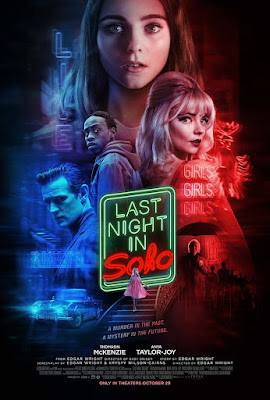It’s clear that Edgar Wright has genre films in his blood. He first gained attention with the zombie comedy Shaun of the Dead (I admit I haven’t seen it, but you’ve got to love that title). Since then he’s worked with much bigger budgets on movies I’ve enjoyed, including the screen version of a wacky graphic novel (Scott Pilgrim vs. the World) and a slam-bang car-crash movie (Baby Driver). I just saw his latest, Last Night in Soho, and couldn’t help thinking of it as a Roger Corman release, though without the T&A. In my book, the Corman comparison is far from an insult. Last Night in Soho was doubtless much costlier than the Corman flicks of my era, and it has a far more polished look, not to mention the appearance of such classic British actors as Rita Tushingham, Terrence Stamp, and the late Diana Rigg in key roles. But like Corman movies of the Stripped to Kill variety, Last Night in Soho has wild audacity and just enough kinkiness to make it mesmerizing.
The classier comparison, I admit, would be to Roman Polanski’s Repulsion. Like that memorable psychological horror film from 1965, Last Night in Soho exists largely in the head of a deeply troubled young woman. Eloise (Thomasin McKenzie of Jojo Rabbit) leaves her loving grannie behind in Cornwall to attend a prestigious fashion institute located in a seedy part of London. Her mother had died tragically many years before, but now Ellie is filled with joy—at least at first—at the thought of making her way as a fashion designer. It’s not long, though, before she’s having disorienting visions of nighttime London in the Swinging Sixties. In these visions she herself, in all her country mousiness, seems to merge with a glamorous young nightclub singer named Sandie (Anya Taylor-Joy), a captivating vision in flowing hot-pink minidress and bouffant blonde hair.
Things get stranger and stranger as the two young women’s identities continue to intertwine. (The film’s brilliant cinematography, which makes elaborate use of reflective surfaces, establishes that the one character is literally the mirror image of the other.) Eventually, as the viewer scrambles to figure out the identity of the mysterious Sandie, it becomes clear that there will be blood. More than that I’d rather not say, except to note that an unexpected story twist is in the offing. You might call it cheesy, but in dramatic terms it strikes me as highly effective. Not everyone agrees, though: I note that something called the Women Film Critics Circle voted Wright into its Hall of Shame for a third-act plot element they feel is demeaning to women.
It's time to tip my imaginary hat to the movie’s cinematographer. Chung-hoon Chung. He is used regularly by a giant of Korean cinema, Park Chan-wook, in such masterworks as The Handmaiden, and I hope we’ll soon see more of his dazzling visuals in English-language films. Thanks to his accomplishments, the film critic of the Los Angeles Times calls Last Night in Soho “without a doubt, the best-looking film of Wright’s career.” There are also some admirable performances, led by the two young female leads. The brunette McKenzie, with her big blue eyes, is the very picture of youthful innocence, and it’s jarring to see her evolve (via a dye job and a new hairdo) into an aspiring Sixties go-go girl. As for Taylor-Joy, who first sprang into my consciousness via TV’s The Queen’s Gambit, she seems capable of any dramatic task that’s set for her however outrageous it might be. The same goes, of course, for Edgar Wright.


No comments:
Post a Comment